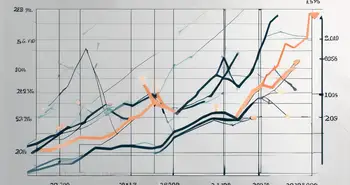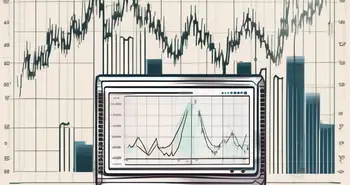The Power of Elliott Wave Analysis

As an expert in the field, I am fully aware of the power and potential behind Elliott Wave Analysis. This powerful tool has the ability to unveil market trends and provide traders with valuable insights into the future direction of financial markets. Whether you are a seasoned investor or just starting out, understanding and utilizing Elliott Wave Analysis can significantly enhance your trading decisions. So, let's dive into the basics and explore the fascinating world of Elliott Wave Analysis.
Understanding the Basics of Elliott Wave Analysis
At its core, Elliott Wave Analysis is a technical analysis approach that seeks to identify recurring patterns in financial markets. It is based on the concept that markets move in distinctive waves, which can be categorized as either impulsive or corrective. By recognizing these waves and understanding their structure, traders can gain a deeper understanding of market trends and make informed trading decisions.
The concept behind Elliott Wave Theory is rooted in the idea that investor psychology drives market movements. According to this theory, markets move in predictable patterns based on the collective emotions of market participants. These patterns, known as Elliott waves, consist of a series of upward and downward price movements that form a larger trend.
The Concept Behind Elliott Wave Theory
Elliott Wave Theory was developed by Ralph Nelson Elliott in the 1930s and has since become one of the most widely used technical analysis tools in the financial industry. The theory suggests that market trends can be divided into five waves in the direction of the main trend, followed by three corrective waves. These waves alternate between motive and corrective phases and create the overall market structure.
Each wave within the Elliott Wave Theory has its own unique characteristics and can be further divided into smaller waves. This fractal nature of the theory allows traders to analyze markets on various timeframes, from minutes to months, and identify potential trading opportunities.
During the motive phase, which consists of waves 1, 3, and 5, the market moves in the direction of the main trend with strong momentum. These waves are often characterized by large price movements and high trading volume. Traders who are able to identify and ride these waves can profit from the upward or downward trend.
On the other hand, the corrective phase, which consists of waves 2 and 4, represents a temporary interruption in the main trend. These waves move against the direction of the main trend and are often characterized by smaller price movements and lower trading volume. Traders who are able to identify these corrective waves can position themselves for potential reversals or pullbacks in the market.
Key Principles of Elliott Wave Analysis
There are several key principles that form the foundation of Elliott Wave Analysis. These principles help traders identify and interpret Elliott waves:
- Wave Principle: The market moves in a series of waves. These waves can be further divided into smaller waves, creating a fractal pattern.
- Fibonacci Ratios: Waves within a trend often exhibit Fibonacci ratios. These ratios, such as 0.618 and 1.618, are derived from the Fibonacci sequence and can be used to identify potential price targets and support/resistance levels.
- Wave Structure: Waves can be classified as impulse waves or corrective waves. Impulse waves move in the direction of the main trend and consist of five sub-waves, while corrective waves move against the main trend and consist of three sub-waves.
- Wave Degree: Waves can be identified on various timeframes, from minutes to months. The larger the timeframe, the higher the degree of the wave.
- Wave Personality: Waves have distinct characteristics and follow certain guidelines. For example, wave 3 is often the strongest and longest wave, while wave 2 tends to be a shallow correction.
By applying these key principles, traders can analyze market charts and identify potential Elliott waves. This analysis can help them anticipate future market movements and make more informed trading decisions.
The Role of Elliott Wave Analysis in Financial Markets
Elliott Wave Analysis plays a crucial role in predicting market trends and guiding trading decisions. By understanding the underlying principles and patterns, traders can gain a competitive edge and improve their overall profitability.
But how exactly does Elliott Wave Analysis work? Let's delve deeper into this fascinating concept.
Predicting Market Trends with Elliott Wave Analysis
One of the key benefits of Elliott Wave Analysis is its ability to predict future market trends. By identifying the current wave count and recognizing the patterns within it, traders can anticipate the direction of the market and position themselves accordingly. This predictive power can be particularly valuable in volatile markets, where accurate forecasting is crucial.
For instance, let's say a trader identifies a completed five-wave pattern, known as an impulse wave, followed by a three-wave correction. According to Elliott Wave Theory, this suggests that the market is likely to resume its previous trend. Armed with this knowledge, the trader can make informed decisions on whether to buy or sell, maximizing their chances of profiting from the market movement.
Moreover, Elliott Wave Analysis provides traders with a framework to assess the strength and duration of market trends. By understanding the wave structure, traders can determine whether a trend is likely to continue or reverse, enabling them to adjust their trading strategies accordingly.
The Impact of Elliott Wave Analysis on Trading Decisions
Elliott Wave Analysis not only helps traders predict market trends but also provides valuable insights into entry and exit points. By identifying key support and resistance levels within the wave structure, traders can effectively time their trades and maximize their profit potential. This strategic approach to trading can significantly improve risk-reward ratios and enhance overall trading performance.
Furthermore, Elliott Wave Analysis can assist traders in managing their risk by providing guidelines on where to place stop-loss orders. By placing stop-loss orders at strategic levels based on wave analysis, traders can limit their potential losses and protect their capital.
It is important to note that Elliott Wave Analysis is not a foolproof method and requires careful interpretation. Traders need to consider other technical indicators, market fundamentals, and risk management principles to make well-informed trading decisions.
In conclusion, Elliott Wave Analysis is a powerful tool that can help traders navigate the complex world of financial markets. By understanding the patterns and principles behind market movements, traders can make more accurate predictions, time their trades effectively, and ultimately improve their trading performance.
Advantages of Using Elliott Wave Analysis
Now that we have explored the role of Elliott Wave Analysis in financial markets, let's delve deeper into the advantages it offers to traders.
Enhancing Market Forecasting with Elliott Wave Analysis
One of the primary advantages of Elliott Wave Analysis is its ability to enhance market forecasting. By studying the wave patterns and identifying the larger market structure, traders can gain a better understanding of the overall market trend. This insight can help them navigate through the noise and make more accurate predictions about future market movements.
Risk Management and Elliott Wave Analysis
Another significant advantage of Elliott Wave Analysis is its potential to improve risk management strategies. By understanding the wave structure and identifying potential reversal points, traders can set effective stop loss levels and minimize potential losses. Additionally, Elliott Wave Analysis can provide traders with a broader perspective on market conditions, helping them avoid entering trades that go against the larger trend.
Challenges in Implementing Elliott Wave Analysis
While Elliott Wave Analysis offers numerous benefits, it is not without its challenges. Implementing this analytical tool requires a deep understanding of the underlying concepts and the ability to interpret wave patterns accurately.
Common Misconceptions about Elliott Wave Analysis
One common misconception about Elliott Wave Analysis is that it provides foolproof predictions. While it is a powerful tool for analyzing market trends, it is not 100% accurate and should be used in conjunction with other technical indicators. It is essential to remember that no analysis can predict the market with absolute certainty.
Overcoming Difficulties in Elliott Wave Analysis Interpretation
Interpreting Elliott Wave patterns can be challenging, especially for novice traders. It requires a keen eye for detail and the ability to differentiate between impulsive and corrective waves. Over time, with practice and experience, traders can overcome these difficulties and develop a more intuitive understanding of the market dynamics.
Future of Elliott Wave Analysis
The field of Elliott Wave Analysis is continually evolving, and the future looks promising. Technological advancements have made it easier for traders to analyze complex wave patterns and make more informed trading decisions.
Technological Advancements and Elliott Wave Analysis
The integration of advanced trading platforms and charting software has significantly simplified the process of conducting Elliott Wave Analysis. These tools provide real-time market data and advanced analytical capabilities that can assist traders in identifying and analyzing wave patterns more efficiently.
The Evolving Role of Elliott Wave Analysis in Market Prediction
As financial markets become more complex and interconnected, the role of Elliott Wave Analysis in market prediction is likely to become even more critical. With its ability to identify major market turning points and forecast future trends, Elliott Wave Analysis will continue to be a valuable tool for traders and investors.
With my years of experience as a financial analyst and trader, I have witnessed firsthand the power of Elliott Wave Analysis in unveiling market trends. It has helped me make more accurate predictions and improve my trading decisions. My personal advice to anyone interested in utilizing this powerful tool is to invest time and effort in learning the underlying principles and gain practical experience by applying it in real-world trading scenarios.
FAQ
What is Elliott Wave Analysis?
Elliott Wave Analysis is a technical analysis approach that identifies recurring patterns in financial markets. Based on investor psychology, it utilizes wave patterns to predict market trends.
How does Elliott Wave Analysis predict market trends?
Elliott Wave Analysis predicts market trends by recognizing and analyzing waves within the market structure. By understanding the current wave count and recognizing patterns, traders can anticipate future market movements.
Does Elliott Wave Analysis guarantee accurate predictions?
While Elliott Wave Analysis is a powerful tool, it does not guarantee 100% accurate predictions. It should be used in conjunction with other technical indicators and analysis methods for more comprehensive insights.
Can Elliott Wave Analysis be difficult to interpret?
Interpreting Elliott Wave patterns can be challenging, especially for novice traders. However, with practice and experience, traders can develop a deeper understanding of wave dynamics and improve their interpretation skills.
Will technology play a significant role in the future of Elliott Wave Analysis?
Yes, technological advancements will play an essential role in the future of Elliott Wave Analysis. Advanced trading platforms and analytical tools will continue to simplify and enhance the process of conducting wave analysis.
In conclusion, the power of Elliott Wave Analysis in unveiling market trends cannot be underestimated. It offers traders valuable insights into market direction, enhances forecasting capabilities, and aids in effective risk management. As the financial markets continue to evolve, mastering this analytical tool will undoubtedly prove to be a valuable asset for any trader or investor.
Ready to harness the power of Elliott Wave Analysis and take your trading to the next level? Look no further than Morpher, the revolutionary trading platform that integrates the precision of blockchain technology for a seamless investing experience. With Morpher, you can trade a diverse range of assets from stocks to sneakers, all with zero fees, infinite liquidity, and the option for up to 10x leverage. Embrace the future of trading with fractional investing, short selling capabilities, and the safety of a non-custodial wallet. Sign Up and Get Your Free Sign Up Bonus today to start trading the smart way!

Disclaimer: All investments involve risk, and the past performance of a security, industry, sector, market, financial product, trading strategy, or individual’s trading does not guarantee future results or returns. Investors are fully responsible for any investment decisions they make. Such decisions should be based solely on an evaluation of their financial circumstances, investment objectives, risk tolerance, and liquidity needs. This post does not constitute investment advice.

Painless trading for everyone
Hundreds of markets all in one place - Apple, Bitcoin, Gold, Watches, NFTs, Sneakers and so much more.

Painless trading for everyone
Hundreds of markets all in one place - Apple, Bitcoin, Gold, Watches, NFTs, Sneakers and so much more.








